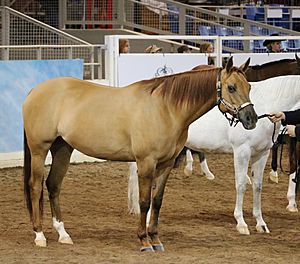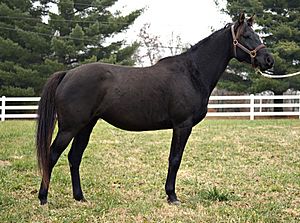Quarab facts for kids

Quarab in horse show competition
|
|
| Country of origin | United States |
|---|---|
| Breed standards | |
| International QuaRab Horse Association | Breed standards |
| Horse (Equus ferus caballus) | |
The Quarab is a special type of horse from the United States. It's a mix of three popular breeds: the Arabian horse, the American Quarter Horse, and the American Paint Horse. This means Quarabs can look a bit like any of these three "parent" breeds.
There are three main types of Quarabs. The "Straight" or "Foundation" type is an even mix of Arabian and stock horse traits. The "Stock" type looks more like a Quarter Horse or Paint. The "Pleasure" type has more Arabian features. People have been mixing these horses for a long time. The first group to officially register Quarabs started in 1984, but it closed later. In 1999, the International Quarab Horse Association (IQHA) was created. It's now the main group for Quarab horses. To be registered, a Quarab must have at least 1/8 Arabian blood and 1/8 stock horse blood.
Contents
What Makes a Quarab Special?
Quarabs show traits from both their Arabian and stock horse family lines. How much they look like one or the other depends on their mix of bloodlines. Arabian-type Quarabs often have longer necks and flatter backs. Stock horse-type Quarabs usually have stronger, more muscular legs and rounded backs.
These horses are usually between 14 and 16 hands tall. (One hand is about 4 inches or 10 cm). The International Quarab Horse Association accepts Quarabs of almost any color or pattern. However, they do not register horses with "leopard complex spotting."
Different Types of Quarabs
As mentioned, there are three main types of Quarabs:
- Straight or Foundation: These horses are a balanced mix of Arabian and stock horse traits. They show influences from both sides equally. Most breeders try to create this type.
- Stock: This type has more traits from the Quarter Horse or Paint horse. Ranchers and people who enjoy Western riding often prefer them.
- Pleasure: These Quarabs show a strong Arabian influence. They have fewer traits from the stock horse side. Riders who enjoy long-distance endurance riding often like this type.
Quarabs are very versatile horses. They compete in many different sports. You can see them in Western riding events like reining and roping. They also do well in English riding sports such as dressage. Besides competing, Quarabs are used for pulling carts, endurance rides, and just for fun pleasure riding.
Quarab History
People have been crossing Arabians, Quarter Horses, and Paint Horses for many years. Records of these crosses go back through the history of the American Quarter Horse Association and the American Paint Horse Association.
For example, in the 1950s, a famous Arabian stallion named Indraff had two foals with a Quarter Horse mare. Both of these foals became very successful. One of them, a filly named Indy Sue, even earned a special award from the American Quarter Horse Association. She also had three registered Quarter Horse foals herself.
How the Breed Was Formed
In 1984, the United Quarab Registry (UQR) was started. This was the first group to register Quarter Horse and Arabian crossbred horses. In 1989, they added a new section called the Painted Quarab Index. This allowed horses with American Paint Horse blood and special color patterns (like tobiano and overo) to be registered. The UQR was a private business and later closed down.
Then, in 1999, the International Quarab Horse Association (IQHA) was formed. This new group continued to register Quarabs using similar rules as the UQR. The IQHA quickly grew and now has members in other countries, like Germany and the Netherlands.
To register a horse with the IQHA, its parents must be registered with their own breed groups. These include the American Quarter Horse Association, the Arabian Horse Association, and the American Paint Horse Association. Also, the horse must have at least 1/8 Arabian blood and 1/8 stock horse blood (from either a Quarter Horse or Paint).


